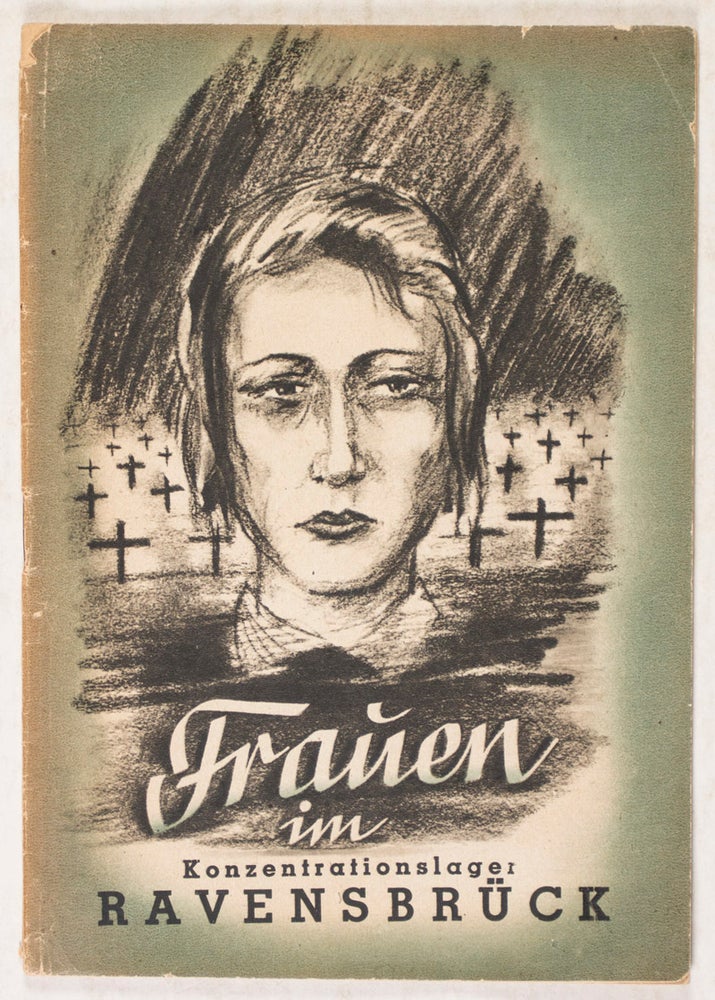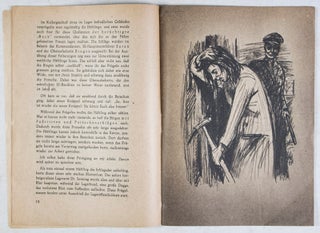Frauen im Konzentrationslager Ravensbrück
Halle: Provinzialverwaltung Sachsen, 1946. First edition. Paperback. Octavo. 31, [1]pp. Original illustrated printed wrappers. Published less than a year after the end of World War II, this booklet is one of the first works on Ravensbrück, the only major Nazi camp for women. Himmler decided to establish a concentration camp for women in Ravensbrück in the fall of 1938. 500 political prisoners were transferred from Sachsenhausen to Ravensbrück in order to build the new camp. They built 14 barracks, a kitchen, an infirmary, as well as a small camp for men, which was totally isolated from the women's camp. The whole camp was surrounded by a high wall with electrified barbed wires on the top. The first prisoners arrived in Ravensbruck on May 18, 1939: 860 German women and 7 Austrian women. From this time, the number of prisoners increased dramatically - 400 gypsy women from Austria arrived on May 29, 1939 and on September 28, 1939, the first women from Poland arrived in the camp. At the end of 1939, the population of the camp was 2,290. After the war began, the population of the camp became more international, and soon there were prisoners coming from 20 European countries. The conditions of life in Ravensbrück were as shameful and difficult as in all the other concentration camps - death by starvation, beating, torture, hanging, and shooting happened daily. The women who were too weak to work were transferred to be gassed at the Uckermark "Youth Camp" located nearby Ravensbruck or to Auschwitz. Others were killed by lethal injections or used for "medical" experiments by the SS doctors. Several SS companies surrounded the camp where the prisoners had to work day and night until they died by weakness and illness. Due to the constant growth of the population, the camp had to be enlarged four times during the war. By the end of 1941, there were 12,000 prisoners. In 1942, several convoys of Russian women were transferred to Ravensbrück. By the end of 1942, the population was 15,000, and it reached 42,000 by the end of 1943. As in the others concentration camps, Ravensbrück had a crematory, and in November 1944, the SS decided to build a gas chamber. At this time, the total population of the camp was 80,000. All in all, more than 132,000 women and children were incarcerated in Ravensbrück. It is estimated that 92,000 of them died in the camp by starvation, executions, or weakness. During the last months of the war, and due to the rapid advance of the Russian Army, the SS decided to exterminate as many prisoners as they could, in order to avoid any testimony about what happened in the camp. For example, 130 babies and pregnant women were gassed in March 1945. At the end of March 1945, the SS decided to transfer the archives of the camp and the machines of the workshops to a safer place. On April 27 and 28, 1945, they ordered the woman still able to walk to leave the camp in a Death March. Only 3,000 exhausted or ill women were left in the camp, as well as 300 men. The camp was liberated by the Russian Army on April 30th, 1945. The survivors of the Death March were liberated in the following hours by a Russian scout unit. This booklet is illustrated with 8 striking reproductions of charcoal drawings (including 7 full-page) depicting the horrors of the camp. Text in German. Wrappers with with some age toning and light wear along edges, chips and creasing. Moderate age toning of block pages. Wrappers in overall good-, interior in good+ condition. g to vg. Item #38012
Price: $300.00


